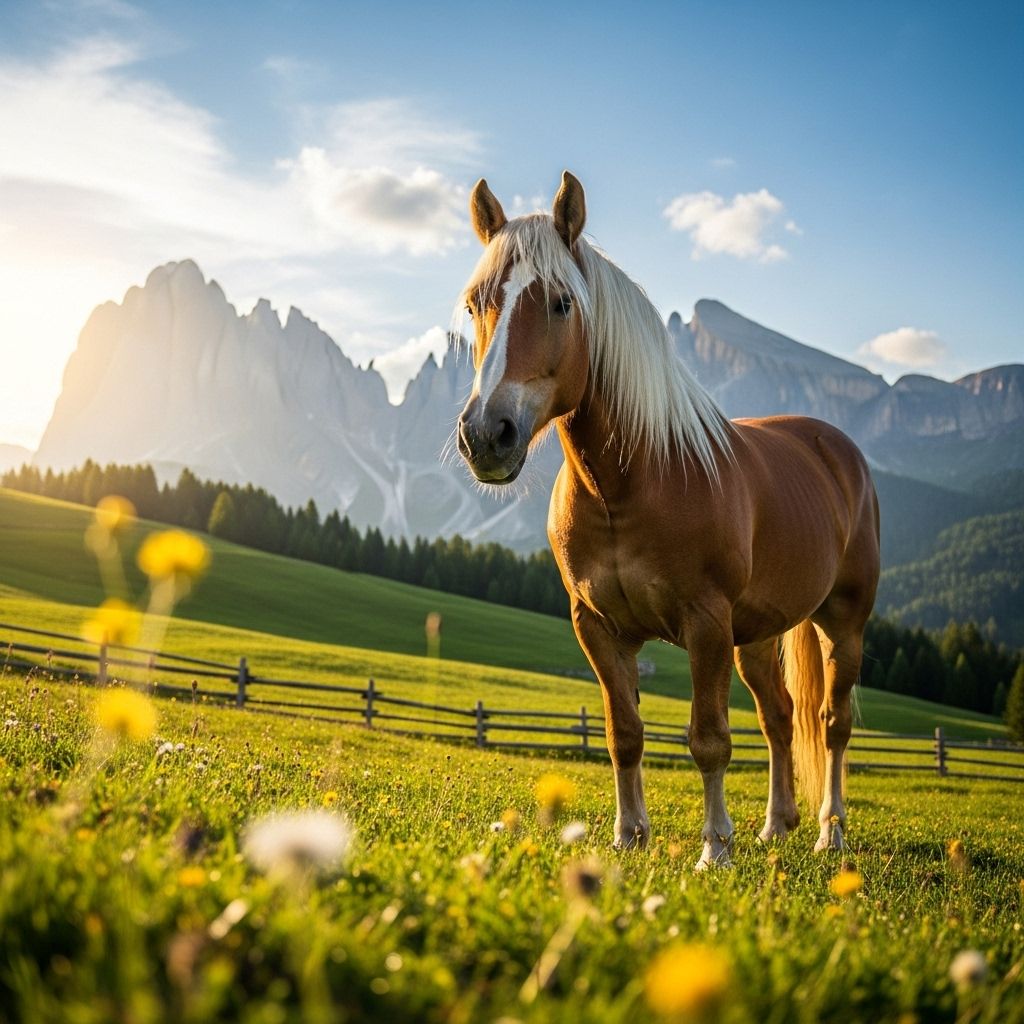Haflinger Horse Breed Guide To History, Uses & Care
Chestnut companions blend alpine resilience with a gentle, family-friendly temperament.

Haflinger Horse Breed Profile
The Haflinger is an iconic horse breed valued for its hardiness, versatility, and characteristic golden-chestnut coloring. Developed in the mountainous regions of Austria and northern Italy, Haflingers excel as riding, driving, and therapy horses thanks to their gentle disposition and sure-footedness. This article covers all aspects of the breed—from its rich history and physical traits to care, health, uses, and FAQs.
Breed Overview
| Breed Name | Haflinger |
|---|---|
| Origin | Austria & Northern Italy (Tyrol region) |
| Size | 13.2 – 15 hands (54 – 60 inches at withers) |
| Weight | 800 – 1,300 pounds |
| Color | Chestnut with flaxen mane and tail |
| Life Expectancy | 25 – 35 years |
| Temperament | Gentle, willing, intelligent, calm |
| Primary Uses | Riding, driving, therapy, family horse, farm work |
History and Origin
Developed in the Tyrol region (spanning Austria and northern Italy), Haflingers emerged primarily out of necessity for a small, strong and agile mountain horse. Medieval writings describe horses in the southern Tyrolean mountains resembling today’s Haflingers, capable of traversing steep, narrow paths and transporting villagers and goods over rugged terrain.
The breed’s formal history begins with the birth of 249 Folie in 1874—a stallion sired by a half-Arabian and a refined Tyrolean mare. Folie became the foundation sire of the breed. All purebred Haflingers today trace their ancestry to Folie through one of seven celebrated lines: A, B, M, N, S, ST, and W.
The breed nearly vanished after World Wars I and II, when larger draft breeds were favored for military use and breeding focus shifted to compact, stout horses capable of carrying heavy loads as pack animals. Post-war, breeding efforts returned to the original goals of producing horses with both refinement and height, leading to the versatile, attractive Haflingers we know today.
- Imported to USA: First Haflingers were imported to America in 1958. The American Haflinger Registry was founded in 1998.
Physical Characteristics
- Size: Haflingers are a small horse breed, typically standing between 13.2 and 15 hands.
- Color: They are always chestnut in various shades—ranging from light gold to liver—with distinctly flaxen (cream or white) mane and tail.
- Build: Muscular yet elegant, the breed has a compact, strong body ideal for riding and driving.
- Head: Features a refined head with expressive eyes and small, alert ears.
- Gaits: Haflingers move with energetic but smooth gaits; their stride is sure-footed and powerful.
- Feet & Legs: Well-formed hooves and sturdy legs suited for mountainous terrain.
Common Variations
- Type: The breed may present either a lighter, more refined riding type or a draftier, stockier model favored for work.
Personality and Temperament
Haflingers are celebrated for their friendly, gentle disposition. They develop strong bonds with their handlers and enjoy working and being part of family life. Historically, their intelligence, willingness to learn, and calmness made them indispensable on small mountain farms, often entrusted with children or elderly handlers.
- Good Natured: Ideal for families and novice riders due to their patience.
- Eager to Work: Enjoy tasks and learn quickly; suitable for many disciplines.
- Reliable: Known for their sure-footedness and ability to navigate tough terrain.
Breed Uses and Disciplines
Today, Haflingers enjoy great popularity worldwide because of their versatility and temperament. Originally bred to navigate narrow mountain trails, their stamina and intelligence suit them to a range of jobs:
- Pleasure Riding: Suitable for children, beginners, and adults with their comfortable size and gaits.
- Driving: Often used in harness for carriage driving, light farm work, and therapeutic programs.
- Dressage & Jumping: Haflingers participate in competitive riding, including dressage and jumping classes. Their agility and willingness make them favorites in youth riding events.
- Therapy Horses: Their calm nature and manageable size make them ideal for equine-assisted therapy and adaptive riding programs.
- Pack Horses: Historically valued for transporting loads over steep paths.
Care and Management
Proper care is essential for maintaining a healthy and thriving Haflinger. Their hardiness, a product of their mountain origins, makes them relatively easy keepers compared to some other breeds, but attention should still be given to the following:
Diet & Nutrition
- Easy Keepers: Haflingers often require less feed than larger horse breeds. Overfeeding can lead to obesity, laminitis, or metabolic syndrome.
- Forage: High-quality hay or pasture is usually sufficient for maintenance.
- Supplements: Minimal grain required; additional vitamins or minerals only if indicated by workload or local forage quality.
Shelter & Environment
- Climate Tolerance: Haflingers can withstand cold weather but should have access to shelter from wind, rain, and extreme temperatures.
- Hoof Care: Their sturdy hooves require regular trimming every 6–8 weeks.
Exercise & Social Needs
- Daily Turnout: Essential for physical and mental well-being; allows for natural movement.
- Companionship: Social horses that benefit from herd interactions or a companion animal.
Common Health Issues
Haflingers are generally robust and healthy, but some individuals may be prone to specific issues:
- Metabolic Syndrome & Laminitis: Due to their easy-keeper status, Haflingers may be at increased risk for metabolic issues and resulting hoof problems.
- Cancer: Some lines have a reported increased risk for certain cancers (e.g., ocular squamous cell carcinoma).
- Dental Care: Routine dental checks prevent tooth overgrowth and discomfort.
- Parasite Control: Regular deworming and preventive care maintain overall health.
Tips for Optimal Haflinger Health
- Routine Veterinary Care: Annual check-ups, vaccinations, dental exams.
- Weight Management: Monitor feed intake, avoid overfeeding.
- Hoof Maintenance: Schedule trims every 6–8 weeks to prevent cracking or imbalance.
Breed Organizations and Registration
Haflingers worldwide are governed by breed registries that ensure purity and standardization. Examples include:
- American Haflinger Registry (AHR): Founded in 1998 to register and promote the breed in the United States.
- Tyrolean Haflinger Breeding Association: Maintains rigorous standards for breeding, tracing horses back to foundation sire Folie.
Is the Haflinger Right for You?
Haflingers make excellent family horses, riding partners, and driving animals for owners seeking a horse with stamina, intelligence, and a manageable temperament. Consider the following factors when deciding if a Haflinger is a good fit:
- Size Suitability: Their moderate height is comfortable for children and adults.
- Temperament: Gentleness and willingness to please make them safe for beginners and enjoyable for experienced equestrians.
- Activity Level: Versatile for both casual and competitive riding, plus driving and therapy work.
- Care Needs: Require regular hoof trimming and preventive health care; manage feed to avoid obesity.
Frequently Asked Questions (FAQs)
Q: What is the origin of the Haflinger?
A: The breed originated in the Tyrol region of Austria and northern Italy and traces every purebred Haflinger back to the stallion 249 Folie, born in 1874.
Q: How big do Haflingers get?
A: Haflingers stand between 13.2 and 15 hands at the withers and weigh between 800 and 1,300 pounds.
Q: What colors are Haflingers?
A: All Haflingers are chestnut with various shades from light gold to deep liver. Their mane and tail are always flaxen (white or cream-colored).
Q: Are Haflingers good for novice riders?
A: Yes, thanks to their calm, willing, and gentle temperament, Haflingers are ideal for children and beginners, as well as professionals seeking a reliable horse.
Q: What health issues may affect Haflingers?
A: Some Haflingers may be prone to metabolic syndrome, laminitis, and certain cancers, but the breed is generally very hardy.
Q: What disciplines can Haflingers participate in?
A: Haflingers are suitable for pleasure riding, driving, dressage, jumping, therapy work, and farm labor thanks to their adaptability and athleticism.
Final Thoughts
Whether you’re an experienced equestrian or a novice owner, the Haflinger horse offers reliability, versatility, and warmth. Their long lifespan and adaptability mean that with proper nutrition, health care, and exercise, a Haflinger can be the cornerstone of your barn for decades.
References
- https://en.wikipedia.org/wiki/Haflinger
- https://madbarn.com/haflinger-horse-breed-profile/
- https://www.webmd.com/pets/what-to-know-about-the-haflinger-horse
- https://becausepony.com/2017/01/03/haflingers-101-history/
- https://www.haflinger-tirol.com/en/haflinger-breeding-association/history-of-the-haflinger-breed.html
Read full bio of Anjali Sayee












